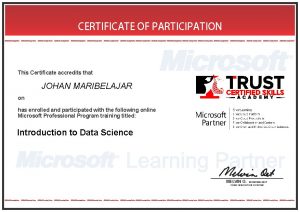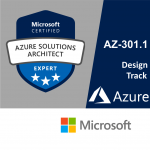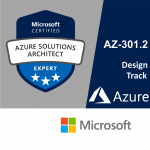Designing an Infrastructure Strategy
Rp500,000 Rp250,000
- Description
- Unit Outline
- Additional information
- Certificate
- Reviews (0)
Description
About this course
Learn how to Describe DNS and IP strategies for VNETs in Azure, compare connectivity options for ad-hoc and hybrid connectivity, distribute network traffic across multiple loads using load balancers, and design a hybrid connectivity scenario between cloud and on-premise.
After completing this course, students will be able to:
- Describe various patterns pulled from the Cloud Design Patterns.
- Distribute network traffic across multiple loads using load balancers.
- Design a hybrid connectivity scenario between cloud and on-premise.
- Design an availability set for one or more virtual machines.
- Describe the differences between fault and update domains.
- Author a VM Scale Set ARM template.
Prerequisites
This course requires that students have the following knowledge and skills:
• Create resources and resource group in Azure.
• Manage users, groups, and subscriptions in an Azure Active Directory instance.
• Build an Azure Virtual Machine with related resources.
• Manage containers and blobs stored in an Azure Storage account.
• Create App Service Plans and manage apps related to the plan.
• Configure an Azure Virtual Network and enable S2S and P2S connectivity.
• Protect networked application components using Network Security Groups.
• Automate everyday Azure resource tasks using Azure CLI or Azure PowerShell.
• Deploy an Azure SQL, MySQL, Postgres or Cosmos database instance.
• Monitor existing Azure solutions using built-in metrics, Application Insights, or Operational Insights.
Estimate Time : 8-12 hours
Module 1 – Application Architecture Patterns in Azure
This module introduces, and reviews common Azure patterns and architectures as prescribed by the Microsoft Patterns & Practices team. Each pattern is grouped into performance, resiliency, and scalability categories and described in the context of similar patterns within the category.
After completing this module, students will be able to:
- Locate and reference the Cloud Design Patterns documentation.
- Locate and reference the Azure Architecture Center.
- Describe various patterns pulled from the Cloud Design Patterns.
Module 2 – Building Azure IaaS-Based Server Applications (ADSK)
This module identifies workloads that are ideally deployed using Infrastructure-as-a-Service services in Azure. The module focuses on the VM Scale Sets and Virtual Machine services in Azure and how to best deploy workloads to these services using best practices and features such as Availability Sets.
After completing this module, students will be able to:
- Design an availability set for one or more virtual machines.
- Describe the differences between fault and update domains.
- Author a VM Scale Set ARM template.
- Join a virtualized machine to a domain either in Azure or on a hybrid network.
Module 3 – Networking Azure Application Components
This module describes the various networking and connectivity options available for solutions deployed on Azure. The module explores connectivity options ranging from ad-hoc connections to long-term hybrid connectivity scenarios. The module also discusses some of the performance and security concerns related to balancing workloads across multiple compute instances, connecting on-premise infrastructure to the cloud and creating gateways for on-premise data.
After completing this module, students will be able to:
- Describe DNS and IP strategies for VNETs in Azure.
- Compare connectivity options for ad-hoc and hybrid connectivity.
- Distribute network traffic across multiple loads using load balancers.
- Design a hybrid connectivity scenario between cloud and on-premise.
Module 4 – Integrating Azure Solution Components Using Messaging Services
This module describes and compares the integration and messaging services available for solutions hosted on the Azure platform. Messaging services described include Azure Storage Queues, Service Bus Queues, Service Bus Relay, IoT Hubs, Event Hubs, and Notification Hubs. Integration services include Azure Functions and Logic Apps.
After completing this module, students will be able to:
- Compare Storage Queues to Service Bus Queues.
- Identify when to use Azure Functions or Logic Apps for integration components in a solution.
- Describe the differences between IoT Hubs, Event Hubs and Time Series Insights.
Additional information
| Author / Publisher | Microsoft |
|---|---|
| Level | Beginner, Intermediate |
| Language | English |
Certificate
When you enrolled into this course you will automatically get a Certificate of Participation for completing the course. An example is provided below.

Only logged in customers who have purchased this product may leave a review.
















Reviews
There are no reviews yet.